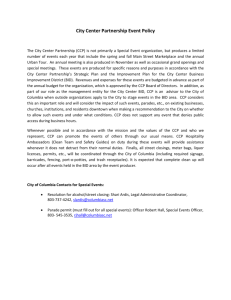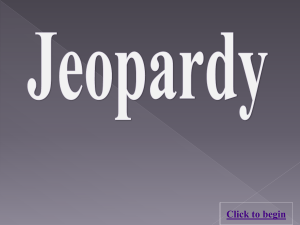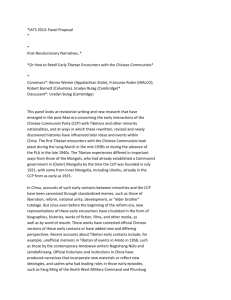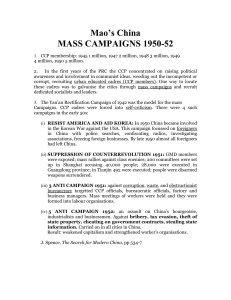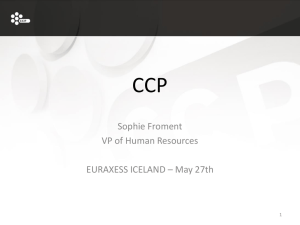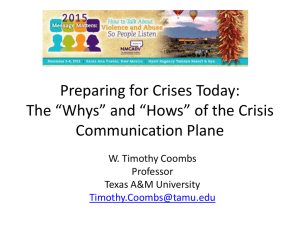U.S. Army War College, The Heritage Foundation, and American Enterprise Institute
advertisement
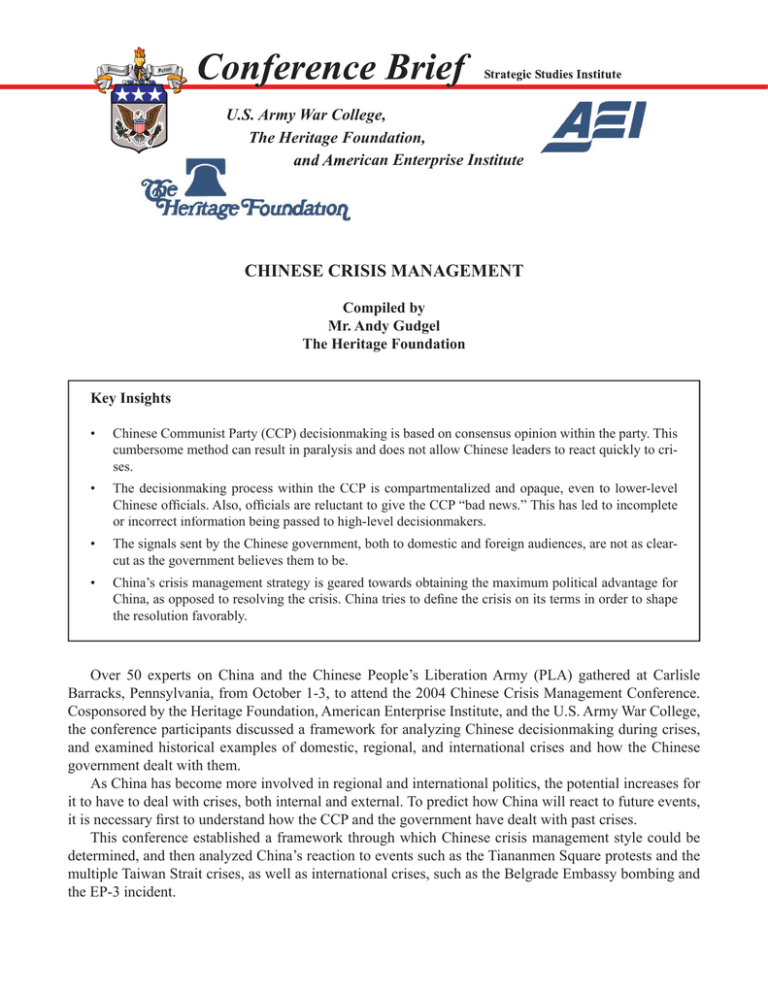
U.S. Army War College, The Heritage Foundation, and American Enterprise Institute CHINESE CRISIS MANAGEMENT Compiled by Mr. Andy Gudgel The Heritage Foundation Key Insights • Chinese Communist Party (CCP) decisionmaking is based on consensus opinion within the party. This cumbersome method can result in paralysis and does not allow Chinese leaders to react quickly to crises. • The decisionmaking process within the CCP is compartmentalized and opaque, even to lower-level Chinese officials. Also, officials are reluctant to give the CCP “bad news.” This has led to incomplete or incorrect information being passed to high-level decisionmakers. • The signals sent by the Chinese government, both to domestic and foreign audiences, are not as clearcut as the government believes them to be. • China’s crisis management strategy is geared towards obtaining the maximum political advantage for China, as opposed to resolving the crisis. China tries to define the crisis on its terms in order to shape the resolution favorably. Over 50 experts on China and the Chinese People’s Liberation Army (PLA) gathered at Carlisle Barracks, Pennsylvania, from October 1-3, to attend the 2004 Chinese Crisis Management Conference. Cosponsored by the Heritage Foundation, American Enterprise Institute, and the U.S. Army War College, the conference participants discussed a framework for analyzing Chinese decisionmaking during crises, and examined historical examples of domestic, regional, and international crises and how the Chinese government dealt with them. As China has become more involved in regional and international politics, the potential increases for it to have to deal with crises, both internal and external. To predict how China will react to future events, it is necessary first to understand how the CCP and the government have dealt with past crises. This conference established a framework through which Chinese crisis management style could be determined, and then analyzed China’s reaction to events such as the Tiananmen Square protests and the multiple Taiwan Strait crises, as well as international crises, such as the Belgrade Embassy bombing and the EP-3 incident. Decision by Committee. The first case of SARS occurred in Guangdong Province in mid-November 2002. While several reports appeared in Chinese newspapers at the outset, by the end of February 2003, the Guangdong Provincial Party Secretary had imposed a media blackout. During this time, SARS had spread to Guangzhou, the provincial capital, as well as Hong Kong. March 2003 saw the disease continue to spread to Beijing, Hanoi, Inner Mongolia, Taiwan, Singapore, and Canada. After a visit from the World Health Organization in late March, China agreed to report on the number of SARS cases regularly. However, when a doctor at a Beijing hospital leaked information that contradicted Ministry of Health pronouncements, the Chinese government was forced to admit to underreporting the cases. In early April 2003, Hu Jintao and Wen Jiabao took the unprecedented step of receiving briefings from respected nonparty experts. In a hasty meeting of the politburo the next week, Hu Jintao admitted that the government had lied and pledged the CCP to an antiSARS campaign. By the end of the month, a massive public-health effort, as well as a major shake-up at all levels of the CCP, was underway. The severity of the SARS outbreak in China, as well as its spread to other countries, can be attributed to the opaque decisionmaking system within the CCP. Party officials, not able to predict the results of the information they provide to higher levels of the CCP, fear to give information that would reflect poorly on themselves or the Party. Consequently, the severity of problems are often understated, or even not mentioned at all, when talking with superiors. By imposing a media black-out, the Guangdong Provincial Party Secretary attempted to sweep the early stages of the SARS epidemic under the rug. In the end, the uninformed public went about their business, inadvertently adding to the number of infected areas. When the CCP became aware of the problem, their reaction was to first deny that there was a problem at all, then provide spurious data on the number of cases. The CCP would only admit the problem and initiate concrete measures to control the epidemic after they were openly contradicted by leaked information. Both culturally and politically, China is a nation of consensus. Agreement (or the withholding thereof) is the means by which parties raise and address individual and group concerns, negotiate, and make decisions with which all parties can agree. Unfortunately, this method of decisionmaking is not well-suited for sudden, unexpected crises. The CCP’s handling of the Tiananmen Square student protests is an excellent example. Soon after the death of Hu Yaobang, the reformist former General Secretary of the CCP, students from several universities in Beijing seized the opportunity to protest corruption within the CCP and to support reform. When the protests began, the CCP quickly became paralyzed with factional infighting over how the incident should be handled. The lack of immediate reaction on the part of the government emboldened the students, who then occupied Tiananmen Square. The occupation increased friction between internal CCP factions, with some supporting the students (either tacitly or directly) and others calling for an immediate end to the protests. Lack of further reactions allowed the students to gain support among Beijing residents. The infighting reached the point where Deng Xiaoping, ostensibly retired from political life, was forced to weigh in, and martial law was declared. But by this point, the entrance of the PLA into Beijing caused the protests to become ugly, with Beijing residents murdering soldiers, and soldiers murdering civilians, culminating in the violent clearing of Tiananmen Square. Had the CCP acted early on, when the students began protesting, or immediately after they occupied the square, bloodshed easily could have been avoided. However, the paralyzed CCP decisionmaking process, due to factional infighting, allowed a small and relatively localized incident to become a major crisis. Left Hand, Right Hand. While superficially similar, in the sense that government inaction allowed a crisis to magnify, the handling (or mishandling) of the SARS epidemic in China in 2002-2003 owed more to the opacity and compartmentalization of the Chinese government than factional infighting. Coming In Loud and Clear? The fractured nature of Chinese decisionmaking makes it very likely that the CCP (or elements within the 2 Chinese government) will send signals that, while they seem clear, may be misinterpreted by their audience. For example, during the early student protests that led to the Tiananmen Square crisis, the Public Security Bureau facilitated the students’ marches by directing traffic. However, within a few days, the same policemen injured several students when they used night-sticks to break up a crowd that refused to disperse. Not long after, the People’s Daily called for a swift, strong response to the protests. Similar articles in other papers also implied that the students were being used by reactionaries as a front to attack the Communist Party. However, simultaneously, numerous CCP bulletin boards in Beijing were encouraging party members to join the students. Such contradictory events certainly emboldened the students. On the one hand, they were condemned in the press; on the other, assisted by elements of the Chinese government. In a similar vein, in its dealings with the United States during multiple Taiwan crises, China has both condemned the United States as an instigator, and implied the need for Washington’s assistance in dealing with Taipei. China often tries to define the parameters of a crisis on favorable terms to maximize benefits while minimizing concessions. In April 2001, a U.S. EP3 reconnaissance airplane and a Chinese fighter jet collided near Hainan Island, killing the Chinese pilot and forcing the crippled EP-3 to make an emergency landing at a nearby PLAAF base. From the outset, the Chinese claimed that the U.S. plane had caused the collision, then landed on their sovereign territory without permission. By drawing out negotiations as long as possible, and repeatedly demanding an apology, China tried to make the United States appear contrite, so as to show that China could “stand up” to it. Conclusion. While the secretive nature and lack of available documents makes it hard to predict exactly how the CCP will react in a crisis, one can look to China’s handling of past crises to get an idea of the trends and themes of its crisis management strategies. Structurally, the CCP (and hence the government) bases its decisionmaking on group consensus. This has had several negative impacts on China’s handling of crises. First, when confronted with a problem, the CCP waits to react until a group decision has been made, allowing small problems to magnify. Second, the opaque and byzantine nature of this process makes CCP members and government officials afraid to give their higher-ups bad news. In the case of the SARS crisis, bad information led to incorrect decisions by the CCP, allowing the disease to spread internally and internationally. Third, the fractured nature of the decisionmaking process causes the CCP to send “mixed messages” about its intentions, as different parts of the government say and do different things. China’s objectives in the process of crisis management can be different from those of other parties. China will often use a crisis to enhance its political prestige, show its power, or wrest concessions from the other side. From the beginning of any crisis, the Chinese will attempt to frame the debate on their terms in order to steer the crisis to a more favorable outcome. Seeking the Advantage. The implied objective of crisis management is to a resolve a crisis before it leads to war. However, it often seems that the objective, in China’s case, is to maximize the advantage. Positions are taken as much to gain political leverage as much as to reduce tensions. In the lead-up to the 1990-91 Gulf War, the United States worried that China would use its veto power in the UN Security Council to block a resolution authorizing military action against Iraq. China used ambiguity over its position to receive a White House meeting, as well as a renewal of Most-Favored-Nation trade status. However, owing to the fact that a veto was tacit support to Iraq’s invasion of Kuwait, the Chinese promptly sidestepped the issue by abstaining when the vote was taken. On the Taiwan issue, China has insisted that Taiwan accept a priori the “one-China principle” in reunification negotiations. Taiwan has refused, as it would be an automatic concession of its interests. China then feels justified in saying that Taiwan, and not Beijing, is delaying better cross-strait relationships. 3 ***** The views expressed in this brief are those of the author and do not necessarily reflect the official policy or position of the Department of the Army, the Department of Defense, or the U.S. Government. This conference brief is cleared for public release; distribution is unlimited. ***** More information on the Strategic Studies Institute’s programs may be found on the Institute’s Homepage at http://www.carlisle.army.mil/ssi/ or by calling (717) 245-4212. 4

